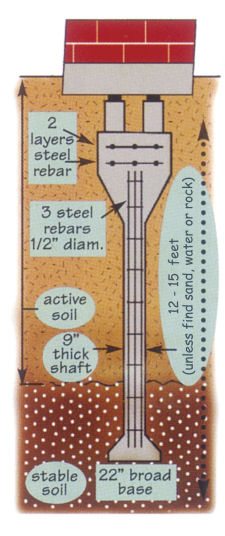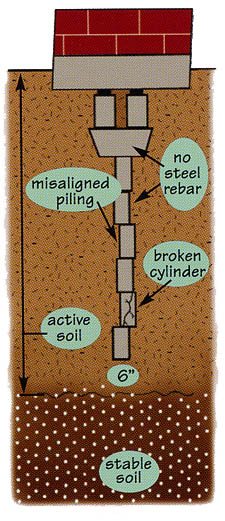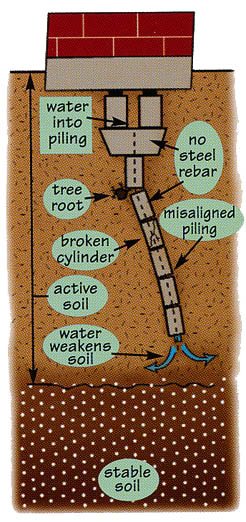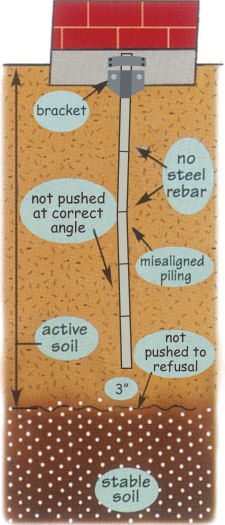Below is a comparison of the four major methods of foundation repair used in Texas. While each has its advantages and its disadvantages, a side-by-side comparison of Dawson’s Bell Bottom Pier method clearly demonstrates that it is the most reliable way to solve a home foundation problem permanently. This method is proven and has been tested over time. This is the same building concept used to build support columns for bridges and highway overpasses. And the following link will help you compare the true cost of foundation repair. When you get the facts, you can be confident in your decision to trust Dawson Foundation Repair.
If you would like a more technical examination of each of the methods of foundation repair, check out ADSC’s (The Association of Drilled Shaft Contractors) article Potential Heave in the Pressed Concrete & Pressed Steel Piles in Residential Foundation Construction which details serious problems with piling methods in the Dallas metroplex area and how they can damage your home’s foundation – or take a look at the conclusions of PhD recipient Tom Witherspoon made in Load Capacity Testing and Analysis of Residential Underpinning Systems in Expansive Clay Environment.
| ♦ | The Bell Bottom Pier Method | |
| ♦ | The Pressed Piling Method | |
| ♦ | The Pressed Piling With Inserts Method | |
| ♦ | The Steel Piling Method |
Bell Bottom Pier Method
At Dawson Foundation Repair, we have built a company and a reputation since 1984 by providing a long-term solution for concerned homeowners. Our work is backed by our years of experience, a lifetime service agreement, and hundreds of foundation repair testimonial letters from our satisfied customers. We know that Bell Bottom Piers is the superior to all other methods of foundation repair because we install it every single day and have seen it perform time and time again.
The bell bottom pier method is the only thoroughly researched concrete slab repair method on the market today. This pier design – poured concrete reinforced with steel rebar – is the same conceptual pier design used in the construction of commercial multi-story buildings, bridges, and highway overpasses. They can be installed in any of the soil and moisture conditions found in Texas and cope equally well from Dallas to Austin to Houston.
Bell Bottom Piers are Permanent, Proven, and Time-Tested. They require more labor, more time, more concrete, and more steel rebar. They can support 5x to 10x more weight, offer stability with a footprint / base that is 13x greater than six inch cylinders, and are built as a single unit for greater strength. The Bell Bottom Pier foundation repair method is, by far, a superior foundation repair method.
| Dawson Foundation’s Bell Bottom Piers The Proven and Permanent Solution |
|||||||||||||||||||||||||||||
 |
Advantages
Disadvantages
|
||||||||||||||||||||||||||||
Click here to see a more detailed diagram of a Bell Bottom Pier
Click here to learn more about the History of the Bell Bottom Pier
Click here to see the step-by-step Foundation Repair Process
Pressed Piling Method
By far the most common of the methods of foundation repair is the Pressed Piling method. It is fast, cheap, and highly profitable for the repair contractor. They are installed all over Texas, but are particularly popular in places with soft, clay rich soil such as Dallas, Houston, Austin, and San Antonio. Pressed pilings are composed of a series of precast concrete cylinders which are installed by digging a hole under the house and then, by using the weight of the home as the driving force, the cylinders are driven into the ground. This method has two major drawbacks: the cylinders are not secured together in any way and the concrete slab is at risk of damage because of the driving process.
Because the cylinders are not secured, they cannot and will not resist horizontal movement, they can easily be pushed into the soil at an incorrect angle, and pilings can crack without being noticed during installation. Because the slab is used in the driving process there is no way to tell how deep the pilings will end up being pushed into the soil. This means that the pilings could reach a point of refusal (the point at which they can go no deeper into the ground) which is not properly anchored in stable soil. If not in stable soil, the pilings provide no benefit, but if an installation crew forces the cylinders beyond this point, they can crack the concrete slab foundation and cause major damage to the home.
 |
Advantages
Disadvantages
|
Click here to read Problems with Pressed Piles
Click here to read about Pressed Piles – Do they meet Building Code Requirements in Texas?
Pressed Piling With Inserts Method
The pressed piling method had so many problems that the people who employed it were forced to come up with ways to fix some of its many drawbacks. The pressed piling with inserts method was one of the variations they came up with. The pressed piling with inserts method uses the same basic technique as the pressed piling method, with one minor change: the concrete cylinders are reinforced in one of several ways (usually with a piece of rebar) to stabilize them as they are driven into the soil.
While this helped somewhat with individual misaligned pilings, the new method did not only fail to fix any of the other drawbacks of the system, but it introduced two new drawbacks as well: Instead of having a single cylinder misaligned, the entire piling could now be skewed and moisture seeping into the gaps can cause the soil to weaken even further.
 |
Advantages
Disadvantages
|
Click here to read Problems with Pressed Piles with Inserts
Click here to read about Pressed Piles NOT meeting Building Codes in Texas
Steel Piling Method
The steel piling method is similar to concrete pilings and attempts to use the strength of steel to overcome the weaknesses that arise with the concrete methods. Pressed steel pilings are primarily used in the Austin, Dallas, and San Antonio areas where conditions are dryer and soils are sandy or soils with harder strata between clay layers which would normally be the refusal point (the point where it takes more force to press the piling deeper than it does to lift the house) for concrete pilings.
Overall steel pilings are similar to the two other piling methods but with two notable differences. First, they have the benefit of being able to be driven deeper into the ground before refusal, which can be a major advantage in dryer soils. Unfortunately, they are frequently not pushed all the way to the refusal point, which means they could sag and fail to properly support the home. The other major difference is that the thinner pilings have less ability to resist the forces of shifting soil, especially upheaval, which can cause severe damage to a home’s concrete slab foundation.
 |
Advantages
Disadvantages
|
FREE Foundation Inspections
Remember, Dawson offers a *FREE foundation inspection for homeowners and commercial property owners (not involved in a real estate transaction).
And we also offer FREE foundation maintenance tips for all of our web site visitors.
Please visit our Frequently Asked Questions (FAQ) page for more information.
FAILED HOME FOUNDATIONS ARE THE NORM IN TEXAS – read the Press Release

Pingback: Texas Foundation Repair Company Promotes Quality | SproutNews